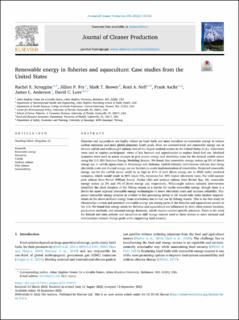| dc.contributor.author | Scroggins, Rachel E. | |
| dc.contributor.author | Fry, Jillian P. | |
| dc.contributor.author | Brown, Mark T. | |
| dc.contributor.author | Neff, Roni A. | |
| dc.contributor.author | Asche, Frank | |
| dc.contributor.author | Anderson, James L. | |
| dc.contributor.author | Love, David C. | |
| dc.date.accessioned | 2023-03-28T06:21:30Z | |
| dc.date.available | 2023-03-28T06:21:30Z | |
| dc.date.created | 2022-11-16T11:31:22Z | |
| dc.date.issued | 2022 | |
| dc.identifier.citation | Scroggins, R. E., Fry, J. P., Brown, M. T., Neff, R. A., Asche, F., Anderson, J. L., & Love, D. C. (2022). Renewable energy in fisheries and aquaculture: Case studies from the United States. Journal of Cleaner Production, 376, 134153. | en_US |
| dc.identifier.issn | 0959-6526 | |
| dc.identifier.uri | https://hdl.handle.net/11250/3060628 | |
| dc.description.abstract | Fisheries and aquaculture are highly reliant on fossil fuels and must transition to renewable energy to reduce carbon emissions and meet global planetary heath goals. Here, we assessed total and renewable energy use in farmed catfish and wild-caught salmon, two of the largest seafood sectors in the United States (U.S.). Interviews were used to explore participants’ views of key barriers and opportunities to replace fossil fuel use. Modeled scenarios were used to assess changes in grid source energy and electricity costs for the farmed catfish sector using the U.S. EIA National Energy Modeling System. We found that renewable energy makes up 5% of direct energy use in catfish aquaculture in Mississippi and Alabama. Catfish industry interviewees indicate that cheap electricity costs and diurnal energy use are barriers to onsite implementation of renewables. Projected renewable energy use for the catfish sector could be as high as 41% of total direct energy use in 2050 under modeled scenarios, which would result in 86% lower CO2 emissions but 34% higher electricity costs. For wild-capture pink salmon from Prince William Sound, Alaska (AK) and sockeye salmon from Bristol Bay, AK, renewable energy makes up 2% and 0% of direct energy use, respectively. Wild-caught salmon industry interviewees identified the short duration of the fishing season as a barrier for onsite renewable energy, though there is a desire for more regional renewable energy technologies to lower electricity costs and increase reliability. Proposed renewable energy projects at utilities in fish processing towns in AK would only make modest improvements in the share of direct energy from renewables due to fuel use by fishing vessels. This is the first study to characterize current and potential renewable energy use among parts of the fisheries and aquaculture sectors in the U.S. We found that energy needs for fisheries and aquaculture are influenced by their often-remote location, production methods, and seasonal energy demands, which require context-specific solutions. There is the need for federal and state policies and incentives to shift energy sources used in these sectors to meet national and international climate change goals while supporting food security. | en_US |
| dc.language.iso | eng | en_US |
| dc.publisher | Elsevier | en_US |
| dc.rights | Navngivelse 4.0 Internasjonal | * |
| dc.rights.uri | http://creativecommons.org/licenses/by/4.0/deed.no | * |
| dc.title | Renewable energy in fisheries and aquaculture: Case studies from the United States | en_US |
| dc.type | Peer reviewed | en_US |
| dc.type | Journal article | en_US |
| dc.description.version | publishedVersion | en_US |
| dc.rights.holder | The authors | en_US |
| dc.subject.nsi | VDP::Landbruks- og Fiskerifag: 900 | en_US |
| dc.source.volume | 376 | en_US |
| dc.source.journal | Journal of Cleaner Production | en_US |
| dc.identifier.doi | 10.1016/j.jclepro.2022.134153 | |
| dc.identifier.cristin | 2074746 | |
| cristin.ispublished | true | |
| cristin.fulltext | original | |
| cristin.qualitycode | 2 | |

